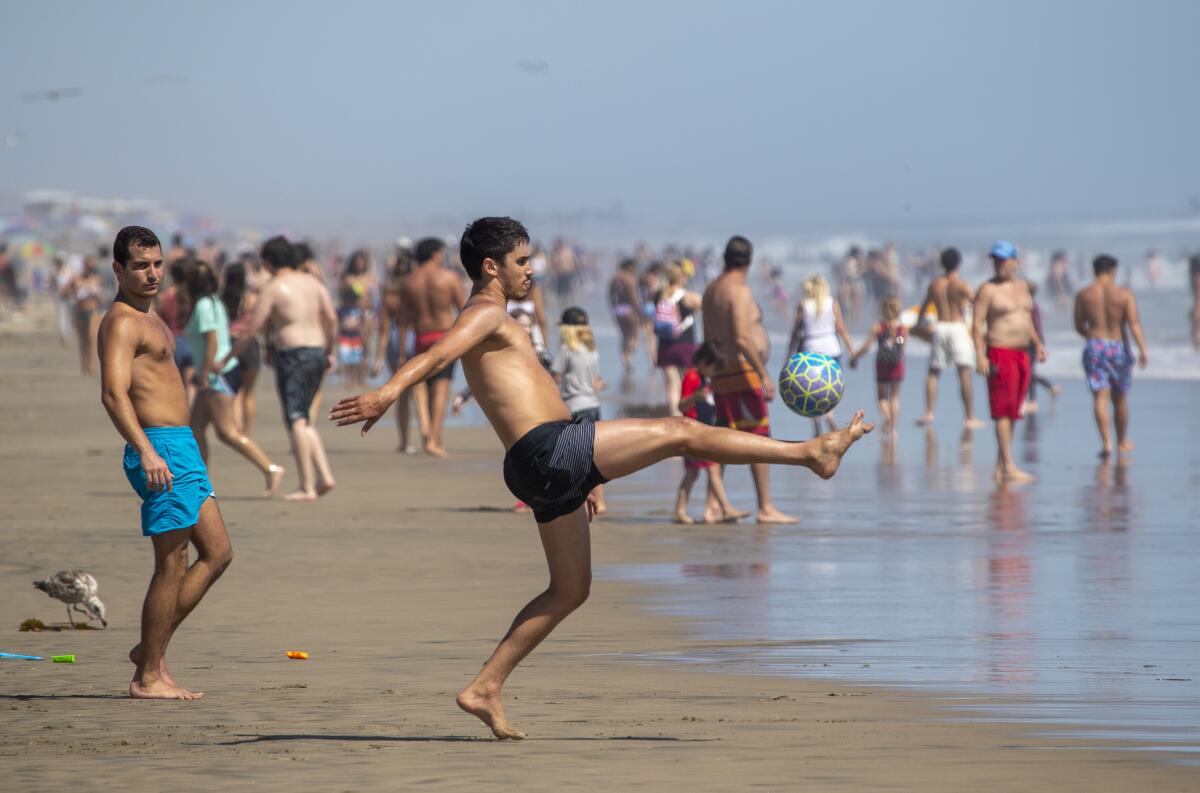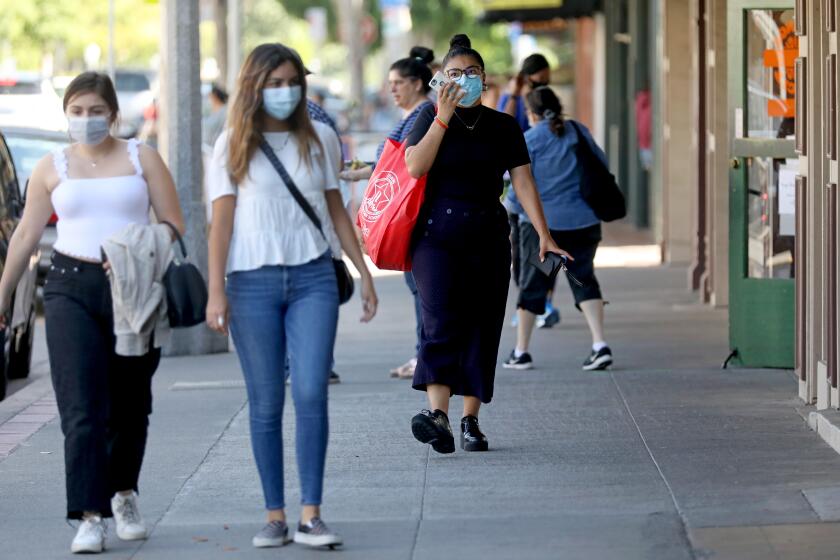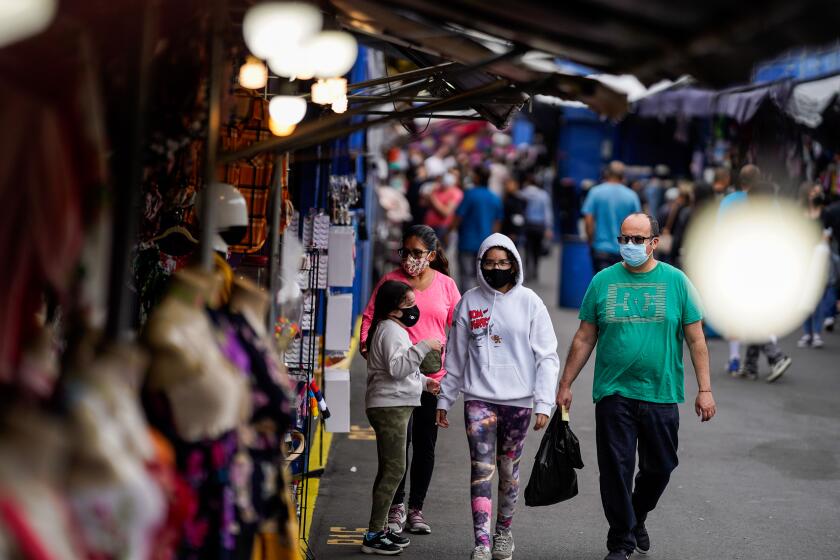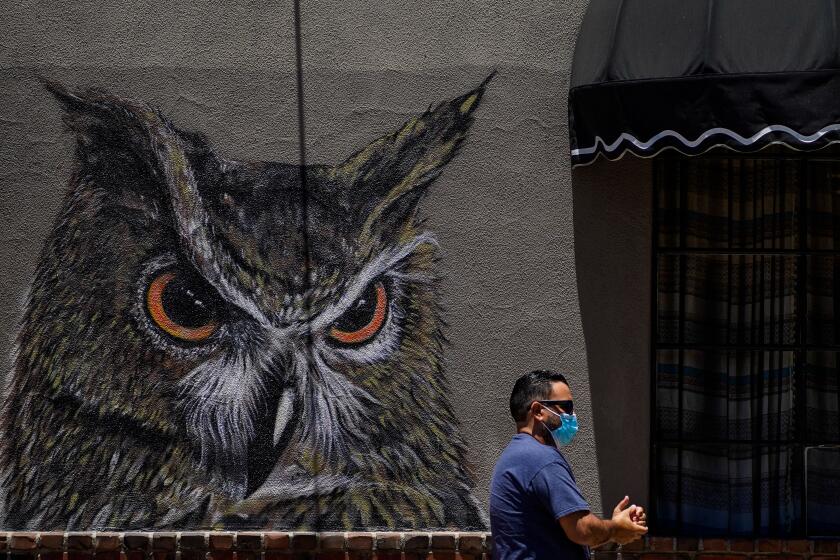Social gatherings help fuel rising coronavirus spread in parts of California

Elevated coronavirus transmissions and related hospitalizations are worsening in some parts of California, and a failure to wear masks in public and increased gatherings are partly to blame, health officials said.
Riverside and San Bernardino counties have recently appeared or reappeared on the state’s list of counties needing targeted monitoring by state officials. In both counties, increases in gatherings were a factor in elevated disease transmission, as were outbreaks at state prisons, nursing homes and patients being transferred from Imperial County, which is home to a particularly bad outbreak.
Gatherings were also a factor in increasing hospitalizations in Santa Barbara, San Joaquin and Stanislaus counties. Officials also blamed “decreased attention to personal protection measures such as face coverings and social distancing” in Stanislaus County, whose largest city is Modesto.
To be sure, California health officials say long-term hospitalization rates remain stable, as is the percent of those testing positive. But there has been an uptick in hospitalizations related to the coronavirus in the last week; between June 14 and June 20, the number of people in the hospital with confirmed and suspected cases of COVID-19 rose from 4,323 to 4,679, an 8% increase.
Health officials say the total in new cases is not the best measure of community spread because of aggressive levels of new testing. They point to other metrics they say shows that the local outbreak has stabilized.
The concern comes as healthcare experts sounded the alarm about growing disease transmission rates across the nation. Community transmission of the highly contagious virus continues to be a problem not only in states such as Arizona, Florida and Texas, but also in California, according to Dr. Scott Gottlieb, a former head of the U.S. Food and Drug Administration, who was speaking on CBS’ “Face the Nation.”
In fact, the pandemic may not slow during the summer as some experts had hoped it might. Instead of distinct waves — a first wave in the spring, followed by a quieter summer and a second wave in the fall — the nation, still stuck in its first wave, may continue to see the pandemic persist without a summer respite.
“This is more like a forest fire. ... Wherever there is wood to burn, this fire is going to burn. And right now, we have a lot of susceptible people,” Michael Osterholm, director of the University of Minnesota’s Center for Infectious Disease Research and Policy, warned Sunday on NBC’s “Meet the Press.” “I don’t see this slowing down through the summer or into the fall. ... I think we’re going to just see one very, very difficult forest fire of cases.”
Some parts of California, including the Bay Area and Los Angeles County, have not seen spikes in hospitalizations even though overall cases are going up.
Barbara Ferrer, L.A. County’s public health director, said Friday that average daily deaths have continued to decline. In early May, L.A. County experienced an average of 45 deaths per day; in early June, there were an average of 20 to 30 deaths reported daily.
Hospitalizations in L.A. County had been steadily decreasing but have recently plateaued, Ferrer said.
It’s possible that a reason for this might be that all hospital patients are being tested for the coronavirus, even if they’re in the facility for a completely different reason. “So we’ll need to watch this information carefully over the weeks ahead,” Ferrer said.
The increase in COVID-19 cases has spurred talk of a “second wave” of coronavirus infections. Experts say that’s the wrong term to describe what’s happening.
In Riverside County, potential transmissions are occurring at public protests with large numbers of people close together and not wearing face coverings.
Patients from northern Baja California seeking care are also a factor in increasing hospitalizations in the county, state officials said. The number of people in the hospital with confirmed or suspected coronavirus infections reported Saturday was 366, a 36% increase from what it was three weeks earlier, on May 30, when 269 people were in the hospital.
San Bernardino County is also seeing increasing hospitalizations, and state officials cited concerns about increasing disease transmission at workplaces, state hospitals, county jails and academy facilities. The number of people in San Bernardino County with confirmed or suspected coronavirus infections on Sunday was 330, a 47% increase from what it was three weeks earlier, on May 30, when 225 people were in hospitals.
Riverside and San Bernardino counties were among those that rescinded mandatory mask orders. Last week, Gov. Gavin Newsom imposed a statewide order requiring masks to be worn in public. Until Newsom’s order, only about two dozen California counties had mandates requiring residents to wear face coverings, the largest being Los Angeles, San Diego, Santa Clara, Alameda, Sacramento, Contra Costa, San Francisco and San Mateo.
The Newsom administration is requiring Californians wear face coverings as coronavirus cases continue to rise in the state.
Out of California’s 58 counties, Riverside County observed the highest percent increase in hospitalizations in the last three days as of Sunday, tallying a 20.9% jump. The other counties the state is tracking include Stanislaus (19.7%), Kings (17.9%), San Joaquin (16.2%), San Bernardino (13.9%) and Fresno (12.4%).
Some public health officials have expressed concern that as the economy opens up, people are assuming they can get back to other routines, such as social gatherings.
“We have found as businesses begin to open up, for some people, there was a sense that things are OK now, and they began having gatherings in the home and birthday parties,” Sacramento County health officer Dr. Olivia Kasirye told the Sacramento Bee earlier this month.
“That is most of the exposure. They are multi-generational. They have people with higher risk,” she added. “You have people together for an extended period of time” not observing six-feet social distancing, and often not wearing face coverings.
San Diego County has also recorded several new outbreaks over the last week — some tied to gatherings.
Of the eight outbreaks reported in the last seven days, the biggest had four or five cases, Dr. Wilma Wooten, the county’s public health officer, said last week. She said no deaths had been associated with any of the outbreaks.
Two confirmed Wednesday and announced Thursday were at a campground and a “social club,” according to county officials.
San Diego County Supervisor Nathan Fletcher said the social club should not have been open.
Officials said they were asking residents to voluntarily comply with the public health orders. If officials find egregious violations at businesses, they could be shut down or cited by law enforcement agencies.
The county refused to release the names of facilities associated with outbreaks. They said outbreaks at businesses had involved only employees, and identifying the places would create the risk of businesses not reporting or cooperating with contact-tracing efforts.
Fletcher acknowledged that gatherings in people’s homes that involve people from different households would present a challenge for law enforcement agencies. Such gatherings are illegal under the county’s public health order.
Wooten said such private gatherings in homes, where people are less inclined to wear masks, would likely be banned under the public health order until herd immunity could be achieved, and that was unlikely to happen this year.
Paul Sisson and Morgan Cook of the San Diego Union-Tribune contributed to this report.
More to Read
Sign up for Essential California
The most important California stories and recommendations in your inbox every morning.
You may occasionally receive promotional content from the Los Angeles Times.














